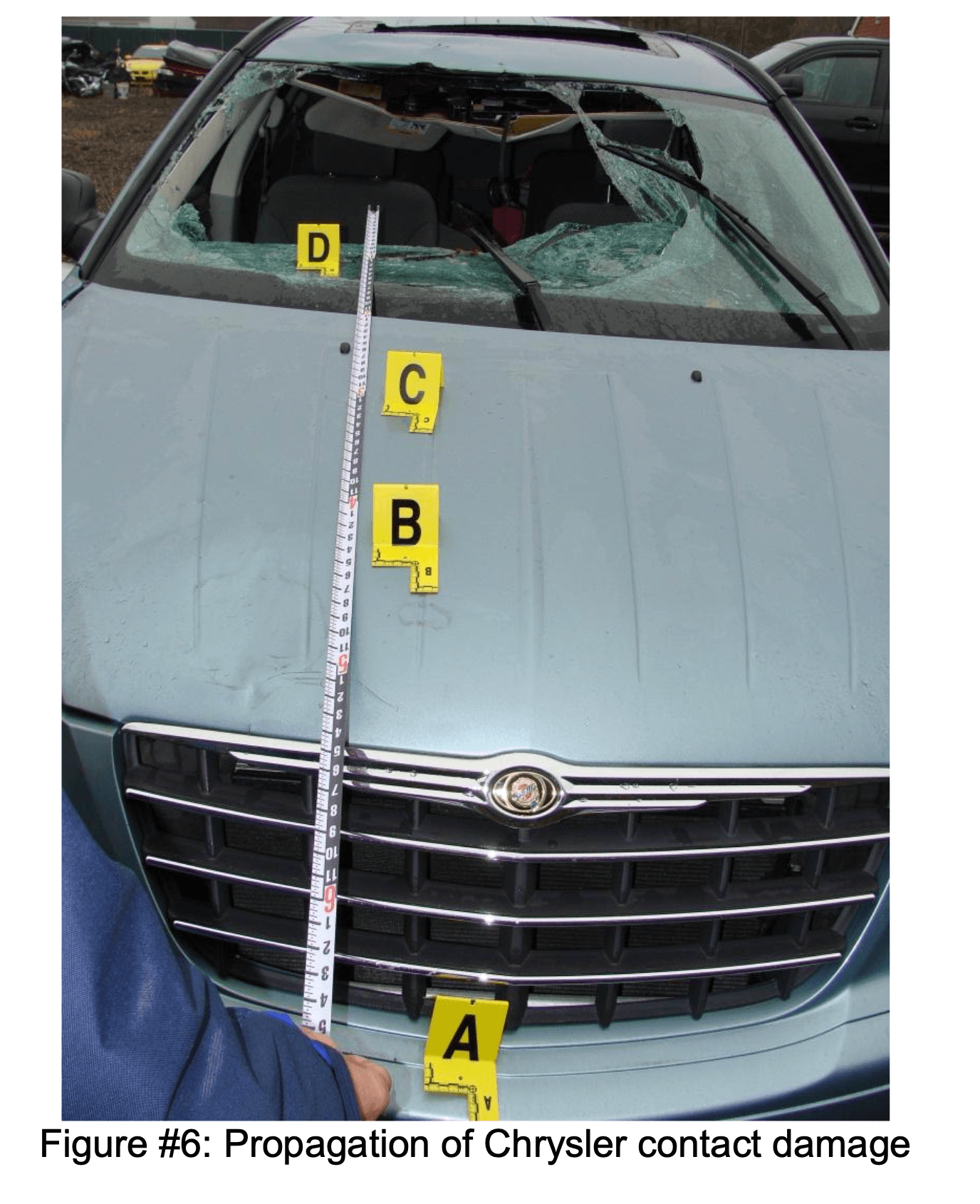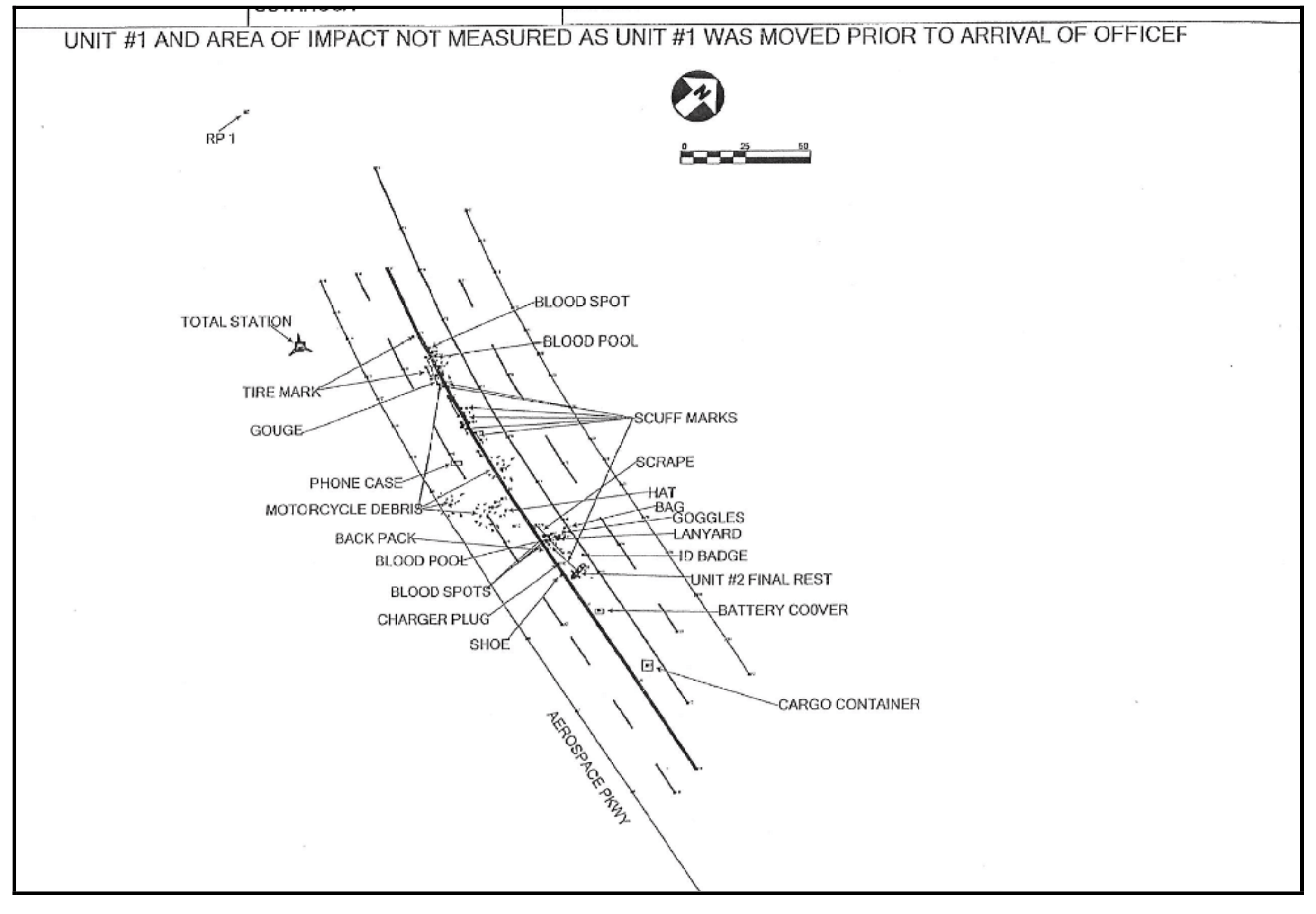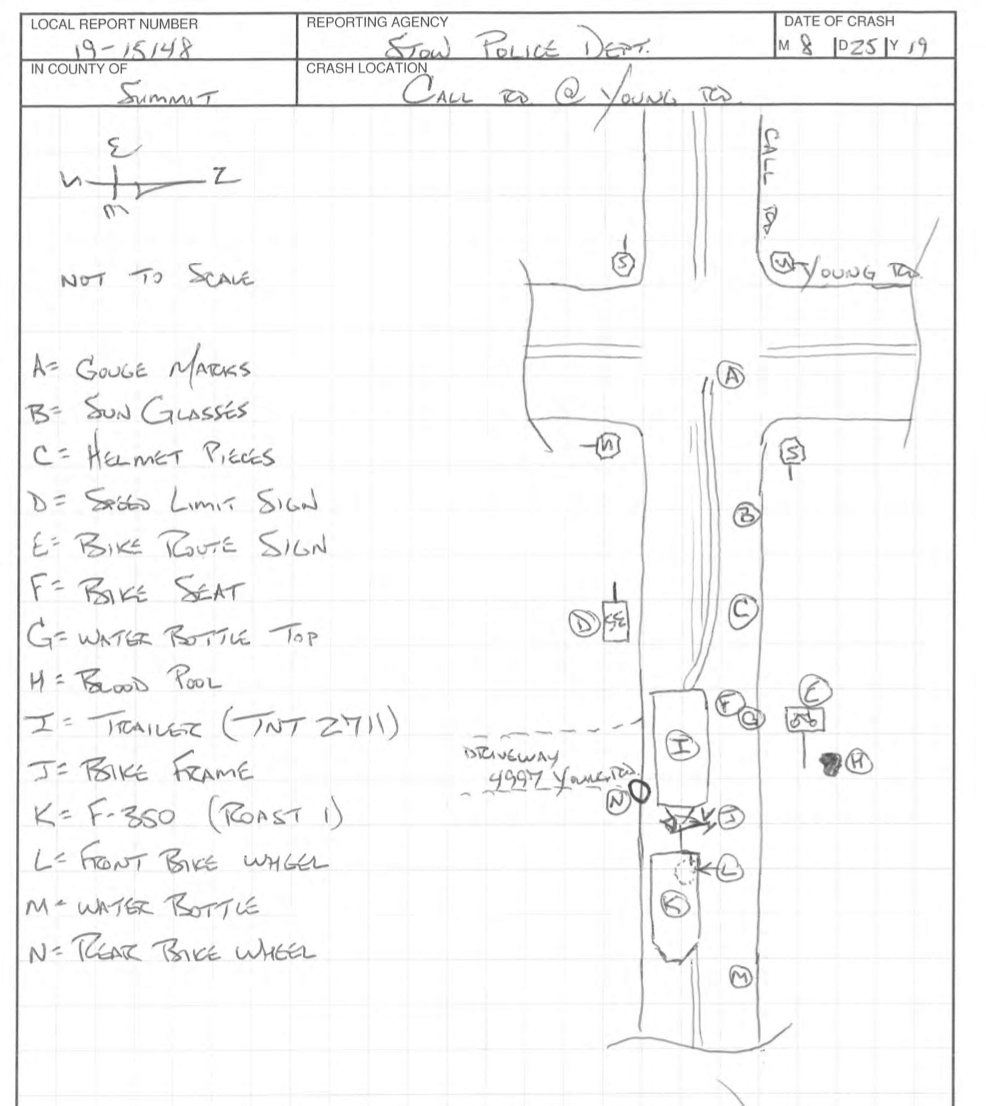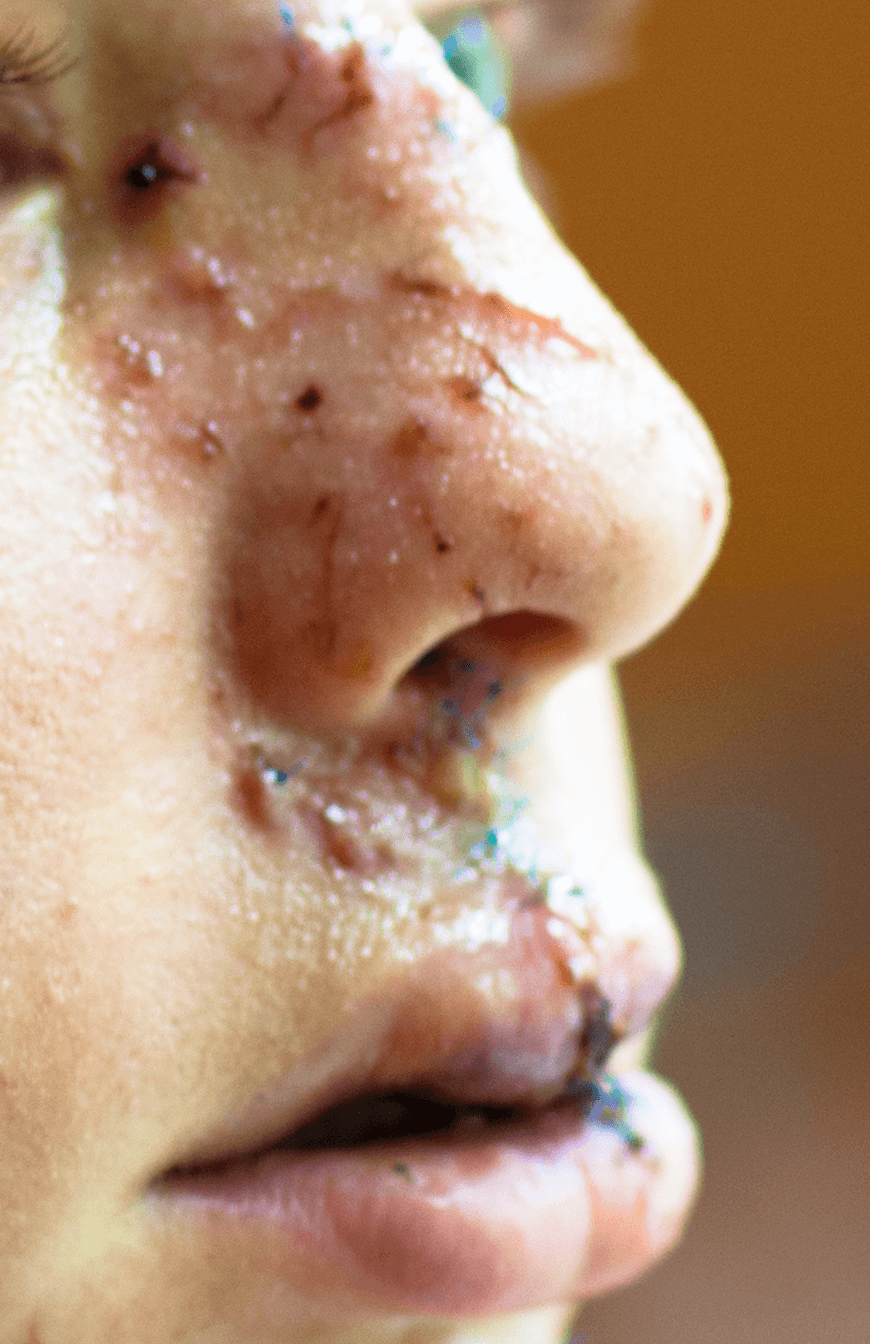WHAT TO DO IF YOU ARE IN A CRASH?
I have seen an article floating around some of the bike pages on the “What To Do If You Crash” topic. It is… how do we say… lacking … in several critical areas, I think… Particularly for Ohio cyclists who crash and are injured when they are struck by a car. WHAT SHOULD YOU DO IF YOU ARE IN A CRASH WITH A CAR?
Here’s a short list off the top of my head…
1. PROTECT YOURSELF – if you can move – move off the road, but BE CAREFUL… Remember Adrenaline is like Magic Fairy Dust that can make you THINK you’re not hurt when you are. Head Injuries, from mild to wild, are common in bike/car crashes and, again, a mild brain shakeup may have saying and doing unusual things… Hopefully you’ll be able to see through the fog and remember these next few items… but PROTECT YOURSELF first and foremost.
2. PROTECT THE SCENE –> leave the bike and debris where it is – Do NOT MOVE ANYTHING on the road – DO NOT allow the car to move if possible – Tell the Driver the car needs to STAY until police arrive – yes, it’ll cause a back up of traffic, but once the scene is changed, evidence is destroyed and it can NEVER be re-done. I can tell you that your first thought will be I GOTTA PROTECT MY BIKE… but DO NOT do that…
Having evidence IN PLACE at the scene when police arrive is very important. Police need to see everything just as it ended up. In a bigger, more serious crash a crash reconstruction may be done. Measurements of everything will be taken… Police now use something called a Total Station to do these measurements. It’s like a fancy computerized surveying transit that takes extremely precise measurements of everything… the bike, the car, skid marks, debris & the debris field, landmarks… Once the scene is moved… it is tainted…and police have to guess
2. GET THE POLICE AND EMT’s to the scene – This SHOULD be a no brainer. But… from my experience cyclists who are whacked by cars are funny sometimes… they often want to dust themselves off and get on their way… they feel almost… embarrassed that THEY got whacked by a car because the OTHER DRIVER WAS CARELESS… Do NOT be that person… don’t go riding off…Get teh Police & EMTs to the scene… I had a client who CALLED ME FROM THE CRASH SITE and asked if she should call the police. Now… we figured out later that her brain was playing tricks on her due to her mild TBI/concussion that she suffered, but she was seriously considering just riding off after being taken out by a right turning car while she was IN THE BIKE LANE… it was raining and the stupid 911 operator was trying to talk her into NOT having police respond… do NOT take that bait… –>ALWAYS get police to the scene
3. DO NOT REFUSE TREATMENT – Remember –> Adrenaline is like Magic Fairy Dust – It makes you think you get up and go – It makes you ignore pain – it makes you think you might not be hurt -IGNORE the Adrenaline Rush & get yourself checked out – Let the EMTs do their thing – it is important for you to start creating a PAPER TRAIL so document your pain and wounds/injuries to the EMTs. Your adrenaline rush will wear off at some point and pain is very likely to set in.
I had one client who was riding along when a smallish puppy came out to play and ran right under his wheel, causing him to go head over handlebars onto the pavement. The owner came out but the cyclist just rode away after talking, declining the pup owner’s request to call 911… a mile or so later, when his adrenaline wore off, he pedaled directly through the front doors into an Urgent Care as he realized his clavicle was extremely painful, and likely fractured.
I had another client who was wearing a helmet cam and when he got rear-ended he got knocked off the bike & his helmeted head hit the pavement. For the next 30 minutes he was talking to folks, telling them he wanted to go- thankfully he got whacked across the street from “Pill Hill”, a collection of hospitals in Cincinnati, and several doctors were eating lunch at Chipotle & saw the crash. They came out & kept him calm and in place. Later, he had NO MEMORY OF ANY OF THIS- Zero – Zip… the video kept playing though, so we could see what he saw and hear what he said… scary…
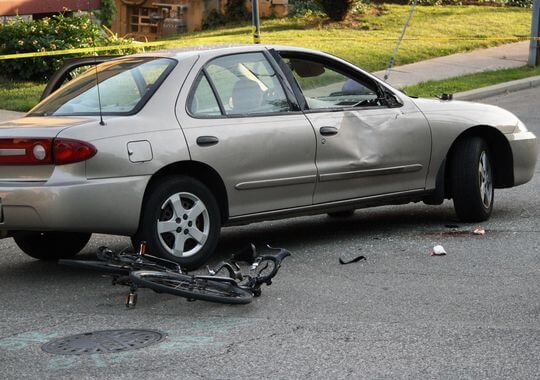
4. If you can, DOCUMENT THE SCENE. & ASK POLICE TO DO SO -Take photos photos and more photos – ASK POLICE TO TAKE PHOTOS – Get the names of everyone – DO NOT ASSUME that if someone talks to the cops that their names will be recorded – they likely won’t. Contrary to cop TV shows, Police at a basic crash site do NOT write down the names of everyone they talk to – So ASK POLICE TO GET NAMES -Police only corral witnesses in obvious “big” cases or when there’s a serious dispute over what happened- typically in severe/fatal crashes. Even in THOSE cases we have found that police may leave out critical information, fail to obtain contact info from critical witnesses or simply do a sloppy job at the scene. Whether your crash is a “run of the mill” crash where the other driver is blatantly at fault or a bigger case with big injuries, make sure the police do their job at the scene if you can. Police should secure the scene, take measurements, take lots of photos, document debris on the ground, get statements from witnesses…many LEOs will call in a special team of crash investigators in a big case…sometimes they try to do it themselves…
5. Do NOT refuse treatment – did I mention that above… oh yea… I wonder why?? Because it is SO IMPORTANT! Cyclists are hard-nosed, self-sufficient, don’t-tell-me-what-to-do, suck it up, get it done, to heck with a little pain, boot-strappers whose first question after returning to a state of quasi-consciousness is “How’s My Bike???” Do not refuse treatment – get checked out – at the scene…and follow up at home… Do NOT MINIMIZE your pain –
6. Only Give a statement to police if you can do so – if you are suffering pain or have a head injury your view of what happened might be skewed – This is difficult to assess in real time- so Be SMART – Be Careful – Report ACCURATELY – Try to get Police to take photos – of your injuries- the scene – all vehicles. Be VERY CAREFUL giving a statement when you are injured. It is OK to say you’re in a lot of pain and you want to give a statement when you have a CLEAR HEAD.
7. GET THE OTHER DRIVER’S INFO –You should NOT leave without the other person’s contact info, the name of their insurer and a policy number preferably. Get a photo of her/his License & Insurance Card if you can. Also get a photo of the license plate & damage to the car if you can. You would THINK the Police would do that but, as noted above, they often do not…
8. Try to find out if the other driver was “working” at the time of the crash and get the name of the employer. Ask POLICE to do this. This could open up another level of insurance coverage to pay your claim.
9. DO NOT CALL THE OTHER DRIVER’S INSURER UNTIL YOU ARE FULLY PREPARED, preferably until AFTER YOU HAVE SPOKEN WITH COUNSEL [as a lawyer representing cyclists hit by dumb motorists I would say DO NOT CALL AT ALL – GET A LAWYER & DISCUSS WITH HER/HIM] – DO NOT simply “start an insurance claim” as one of the bad articles I’ve seen floating around the internet suggests. Again, DO NOT simply call up the driver’s insurer and “report” the claim. This ought to be done after much thought – with much preparation.
The initial communications with the insurer can be critically important. Having worked as in-house counsel for an insurer I know that insurers are required to set “reserves” on cases on Day 1 – as a lawyer for the victim I know that using the right language, the best descriptions, the right buzz words, on Day 1 can cause the reserve to be set as high as possible. Getting this done well on Day 1 will set up a more favorable resolution on Day 100 or Day 700… SO Do NOT call the Insurer – Do NOT “give them a statement” – They’ll tell you – “Oh, it’s just a short statement – we need your story for our records blahblahblah” – Also ABSOLUTELY DO NOT give them your Social Security Number.
This same advice goes for talking to YOUR insurer as well. If you follow my posts you know that you MIGHT have coverage in your AUTO and HOMEOWNER’s policies that could help you in a case where you were hit by an errant motorist. If you have big injuries and an umbrella policy that umbrella can also come into play. Just like contacting the motorist’s insurer, though, any communication with YOUR insurer needs to be done tactically – intelligently – and with much preparation. As stated above there is a way I like to present the case on Day 1 that, strategically, sets us up for success down the road. TALK TO A LAWYER first.
10. Do NOT give out your AUTO INSURANCE INFO to doctors, hospitals and the like. They’ll certainly ask. In Ohio, anyway, your care providers have taken the approach of ignoring your health insurance and submitting claims to your auto insurance to try to tap into your “Medical Payments” coverage.
Why?
Well… MONEY of course…
Your health insurer will only pay a percentage of the bill – maybe 50% or less – whatever the negotiated rate is. If you have Medicaid or Medicare that percentage is a lot lower. The hospital knows that your auto carrier may pay 100 Cents on the Dollar instead of the 50 or 60 cents they might get from your insurer – or the 30 cents they could get from Medicare. The hospital knows that it must be AGGRESSIVE and get to your policies first before any other medical care providers you may see…
In your Auto policy you may have “Medical Payments” coverage. This is coverage to pay crash-related medical bills, regardless of fault. As long as you were in a car crash this Med Pay coverage applies. Even if you are sitting on a bench at a bus stop & get his by a car that jumps the curb, YOUR Auto policies Med Pay can help with out of pocket medical bills. These are usually small coverage amounts – $1,000, maybe $5,000 – sometimes $10,000 or more. But you may find that you have a LOT of out of pocket bills – deductibles, co-pays, or your 20% share under an 80/20 health insurance policy. The MedPay is designed to cover this…
Whatever the E/R submits to your Auto/Med Pay carrier, up to your policy limits, may be paid by your Auto insurer with virtually no questions asked and WITHOUT YOUR KNOWLEDGE OR CONSENT.
Well… actually you DID consent-those forms you sign when you go to a hospital give the hospital the right to tap into ANY insurance it can find.
I had one case where a guy had $10,000 in “Med Pay” – and we discovered that his auto insurer PAID ALL OF IT to the E/R facility without his knowledge or consent before I even got involved! That left him on the hook for a large deductible.
YOU should remain in control of that money – you may need it to pay your deductible, or the 20% of the “80/20” policy that you owe. One of the first letters I write in a new case is to the Client’s Auto Insurer instructing the insurer to NOT pay MedPay to ANYONE without the client’s express written consent.
11. TRIGGER ALL APPLICABLE INSURERS There are as many as 4 or 5 insurance policies which can be triggered at the moment of a crash – Your Health insurance, Auto Insurance, the other guy’s Auto insurance – the other guy’s Employer’s insurance, your HOMEOWNER’s insurance and any “umbrella” or excess coverage you may have. As I researched and wrote the “Insurance” chapter in “Bicycling and the Law” I dug deep into the relationships of all these carriers – it’s not pretty… I recently explored this topic here– Does your Homeowner’s Policy play a role here? What coverages in your AUTO policy may help you? Does YOUR Umbrella Have a HOLE In It? Read the piece and find out! Understand- these claims get COMPLICATED in a HURRY –
12. Ok, this one is directly from my Department of Shameless Self Promotion: IF you have a claim of ANY magnitude at all – disabling injuries, big bills, scars and wounds, fractures, serious out of pocket losses or wage loss, then CALL A GOOD LAWYER ASAP – EARLY in the game – BEFORE YOU TALK TO ANY INSURER – don’t go through the process yourself and then call a lawyer when it gets mucked up… If there is ANY suggestion that YOU were at fault, CALL A LAWYER. This comes up in almost EVERY “bike” case – Why? Because “Bike Laws” are rarely reviewed by insurers, and not understood. My clients tend to be folks who ride a lot and KNOW what they’re doing but find Insurance Adjustors claiming they did something wrong. CALL A LAWYER. How do you know if you have a “small” claim? Tough to say – minor injuries which heal quickly and no complications. Clear liability. Nice adjustor who wants to give away some money and finish the claim… For all the rest, you’re likely going to need counsel.
13. GET MY FREE CRASH CARD – Send me an Email [BikeLawyer@me.com] and I’ll send you 10-100-1000+ of my Bike Law/Art Cards. Give them to your riding buddies – stick them in your kids’ stockings at Christmas. Give them as Valentine’s Day gifts, Birthday gifts like personalized photo necklace… pass them out at Rides or Events. Read the card – Very HELPFUL stuff… and Did I mention it was FREE
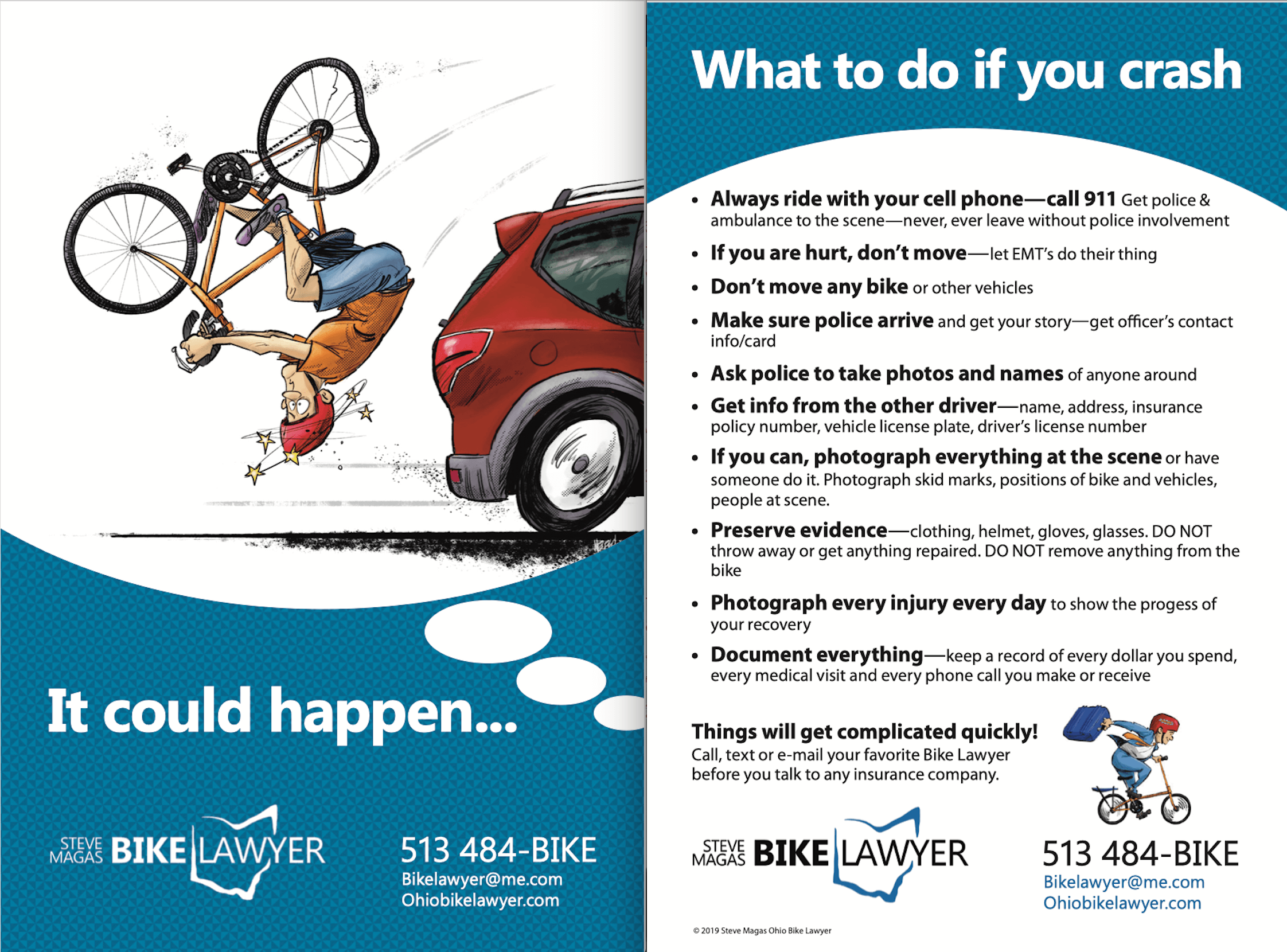 14. GET MY FREE BIKE LAW CARD Send me an Email and I’ll send you 10-100-1000+ of my Bike Law/Art Cards. Keep ’em handy – you never know when they’ll come in handy.
14. GET MY FREE BIKE LAW CARD Send me an Email and I’ll send you 10-100-1000+ of my Bike Law/Art Cards. Keep ’em handy – you never know when they’ll come in handy.
In recent years I have been working with another bike lawyer, Chris Carville, who is also licensed in Kentucky. Chris & I designed these cards with detailed Bike Law data so riders could have both Ohio & Kentucky Bike Law at their fingertips
The idea is that if a police officer stops you and, say, tells you you’re not allowed to ride on the road you can whip out the Bike Law/Art card, flip the card to the proper State and show the officer the actual Code sections that apply! I know there is at least one YouTube video out there in which the card was successfully used in this fashion!
15. Keep track of EVERYTHING! Every document relating to your injuries is important. The EOB’s from your insurer- the bills – your payment of the bills – photos – your bike – your helmet and bloody clothes… keep EVERYTHING –
A few years ago, the Ohio Supreme Court, in its infinite wisdom, changed the rules for ALL injury claims in which health insurance is involved. It made our jobs of representing you far more difficult, and helped tamp down the value of claims. The Ohio Supreme Court gave the person that HIT you a huge advantage by allowing that person & her/his insurer the right to find out if you have insurance and what your insurance paid.
Prior to this case, I would introduce the FULL AMOUNT of your actual BILLS – say $10,000 – and the jury would start there and go up for an award of pain & suffering and other damages. Now, I can still submit the actual bill but the insurer/defense is allowed to say “Hold on, sure $10,000 was billed, but the doctors & hospitals agreed to accept a lot less as full payment – only $6,000” The jury is supposed to figure out what to do with that. Our Supreme Court now requires you [and me] to keep track of your insurance payments, your insurance policy terms, your premiums, all the “write offs” your health insurance makes, your share of the bills, your deductible and more… it’s crazy… but that’s the landscape we’re playing in these days…
16. TAKE LOTS AND LOTS OF GOOD Photos – Get GOOD photos of wounds, scars, bloody goopy stuff… hospital shots are fantastic [in the crazy little world I work in]. But GOOD photos – did I mention that the photos have to be GOOD – I cannot TELL you how many times I’ve received an envelope of photos…out of focus photos … of fleshy blobs… with no possible way to tell WHO it is… or WHAT body part was in the photo… Today’s phones are amazing and can take pretty decent photos – but for a bigger case I’m talking about pro quality photos – images that will help sell the case – I have invested heavily in high end Canon camera gear and shoot a LOT of photos in my cases – I’ve got wide angle lenses, close up lenses, flashes and a tripod. I’ve got props that measure wounds, backgrounds and high end f1.2 lenses that take gorgeous photos of gory stuff… I usually shoot 100 or so photos in every case… the scene – the property damage – the bike, jersey, shoes, helmet, gloves – and then the wounds and scars…
So There you go – my Top Ten …errr… Sixteen Things to do or think about after you crash… This is the tiny tippy top of the iceberg of To Do’s in a typical bike crash case… I could write a book, oh wait I AM writing a book on each one… For now YOU should be aware that while a crash can be complicated & messy, so can the post-crash shenanigans pulled by insurers… PROTECT YOURSELF …
Stay Safe and Keep On Riding!
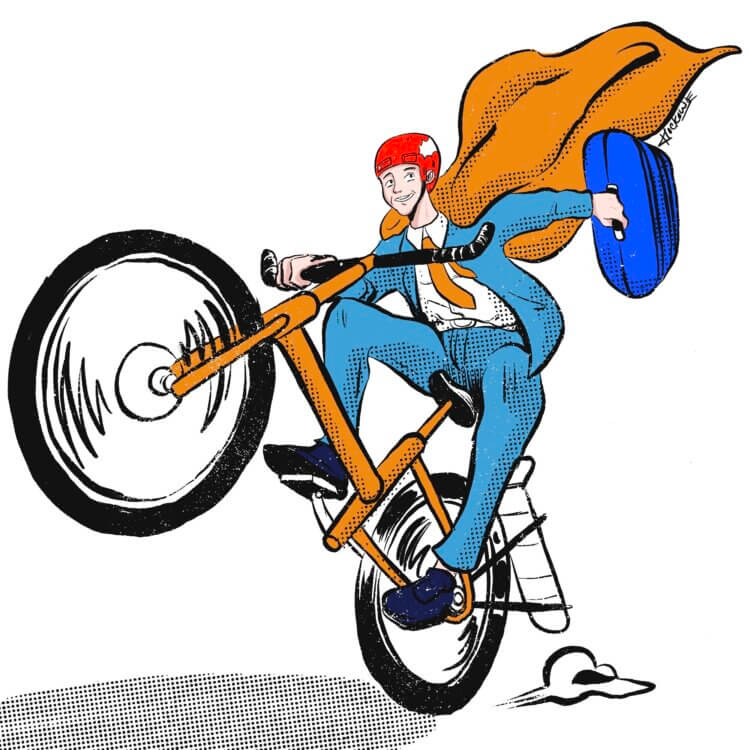
© 2025.
